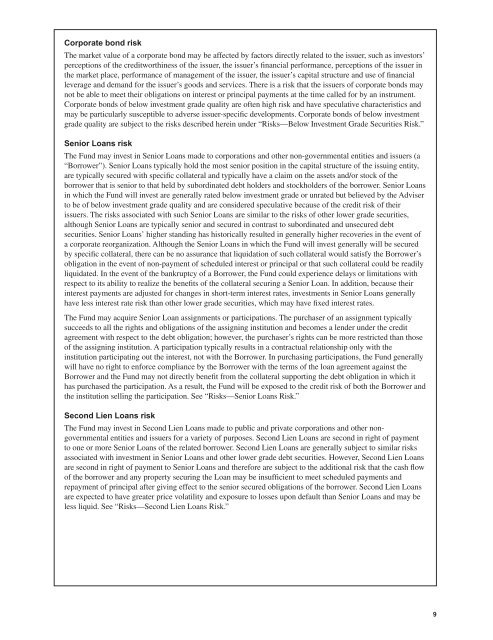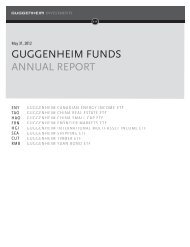Guggenheim Credit Allocation Fund GGM - Guggenheim Investments
Guggenheim Credit Allocation Fund GGM - Guggenheim Investments
Guggenheim Credit Allocation Fund GGM - Guggenheim Investments
- No tags were found...
Create successful ePaper yourself
Turn your PDF publications into a flip-book with our unique Google optimized e-Paper software.
Corporate bond riskThe market value of a corporate bond may be affected by factors directly related to the issuer, such as investors’perceptions of the creditworthiness of the issuer, the issuer’s financial performance, perceptions of the issuer inthe market place, performance of management of the issuer, the issuer’s capital structure and use of financialleverage and demand for the issuer’s goods and services. There is a risk that the issuers of corporate bonds maynot be able to meet their obligations on interest or principal payments at the time called for by an instrument.Corporate bonds of below investment grade quality are often high risk and have speculative characteristics andmay be particularly susceptible to adverse issuer-specific developments. Corporate bonds of below investmentgrade quality are subject to the risks described herein under “Risks—Below Investment Grade Securities Risk.”Senior Loans riskThe <strong>Fund</strong> may invest in Senior Loans made to corporations and other non-governmental entities and issuers (a“Borrower”). Senior Loans typically hold the most senior position in the capital structure of the issuing entity,are typically secured with specific collateral and typically have a claim on the assets and/or stock of theborrower that is senior to that held by subordinated debt holders and stockholders of the borrower. Senior Loansin which the <strong>Fund</strong> will invest are generally rated below investment grade or unrated but believed by the Adviserto be of below investment grade quality and are considered speculative because of the credit risk of theirissuers. The risks associated with such Senior Loans are similar to the risks of other lower grade securities,although Senior Loans are typically senior and secured in contrast to subordinated and unsecured debtsecurities. Senior Loans’ higher standing has historically resulted in generally higher recoveries in the event ofa corporate reorganization. Although the Senior Loans in which the <strong>Fund</strong> will invest generally will be securedby specific collateral, there can be no assurance that liquidation of such collateral would satisfy the Borrower’sobligation in the event of non-payment of scheduled interest or principal or that such collateral could be readilyliquidated. In the event of the bankruptcy of a Borrower, the <strong>Fund</strong> could experience delays or limitations withrespect to its ability to realize the benefits of the collateral securing a Senior Loan. In addition, because theirinterest payments are adjusted for changes in short-term interest rates, investments in Senior Loans generallyhave less interest rate risk than other lower grade securities, which may have fixed interest rates.The <strong>Fund</strong> may acquire Senior Loan assignments or participations. The purchaser of an assignment typicallysucceeds to all the rights and obligations of the assigning institution and becomes a lender under the creditagreement with respect to the debt obligation; however, the purchaser’s rights can be more restricted than thoseof the assigning institution. A participation typically results in a contractual relationship only with theinstitution participating out the interest, not with the Borrower. In purchasing participations, the <strong>Fund</strong> generallywill have no right to enforce compliance by the Borrower with the terms of the loan agreement against theBorrower and the <strong>Fund</strong> may not directly benefit from the collateral supporting the debt obligation in which ithas purchased the participation. As a result, the <strong>Fund</strong> will be exposed to the credit risk of both the Borrower andthe institution selling the participation. See “Risks—Senior Loans Risk.”Second Lien Loans riskThe <strong>Fund</strong> may invest in Second Lien Loans made to public and private corporations and other nongovernmentalentities and issuers for a variety of purposes. Second Lien Loans are second in right of paymentto one or more Senior Loans of the related borrower. Second Lien Loans are generally subject to similar risksassociated with investment in Senior Loans and other lower grade debt securities. However, Second Lien Loansare second in right of payment to Senior Loans and therefore are subject to the additional risk that the cash flowof the borrower and any property securing the Loan may be insufficient to meet scheduled payments andrepayment of principal after giving effect to the senior secured obligations of the borrower. Second Lien Loansare expected to have greater price volatility and exposure to losses upon default than Senior Loans and may beless liquid. See “Risks—Second Lien Loans Risk.”9



